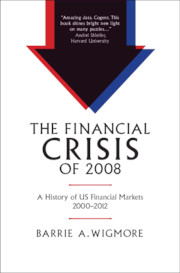Book contents
- The Financial Crisis of 2008
- Studies in Macroeconomic History
- The Financial Crisis of 2008
- Copyright page
- Dedication
- Contents
- Introduction
- 1 The Heritage of the Hi-Tech Bubble 2000–2004
- 2 The Stretch for Higher Returns 2004–2006
- 3 The Impending Storm – 2007
- 4 The Crisis – 2008
- 5 What Caused the Crisis?
- 6 The Initial Obama Administration 2009
- 7 Recovery 2010–2012
- 8 Epilogue 2012–2016
- Acknowledgments
- Charts
- Tables
- Acronyms
- Bibliography
- Index
- Studies in Macroeconomic History
- Plate Section
7 - Recovery 2010–2012
Published online by Cambridge University Press: 07 October 2021
- The Financial Crisis of 2008
- Studies in Macroeconomic History
- The Financial Crisis of 2008
- Copyright page
- Dedication
- Contents
- Introduction
- 1 The Heritage of the Hi-Tech Bubble 2000–2004
- 2 The Stretch for Higher Returns 2004–2006
- 3 The Impending Storm – 2007
- 4 The Crisis – 2008
- 5 What Caused the Crisis?
- 6 The Initial Obama Administration 2009
- 7 Recovery 2010–2012
- 8 Epilogue 2012–2016
- Acknowledgments
- Charts
- Tables
- Acronyms
- Bibliography
- Index
- Studies in Macroeconomic History
- Plate Section
Summary
Paul Krugman wrote in January 2009, “We’re living in a Dark Age of Macroeconomics.” The securities markets disagreed. The S&P 500 rose 80% from its early 2009 low to December 2010 (Chart 7.1). Clearly investors were looking ahead because all during 2009 analysts’ earnings expectations for the next year remained dismal, but during 2010 their expectations for 2011 earnings rose 25% (Chart 7.2).
- Type
- Chapter
- Information
- The Financial Crisis of 2008A History of US Financial Markets 2000–2012, pp. 316 - 341Publisher: Cambridge University PressPrint publication year: 2021

